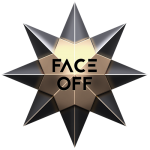
I can’t express to you how much I hate waiting for my turn.
I think the best part of a board game is sitting around the table after the game is over and, win, lose or draw, talk it over with my friends and brothers.
“This is what I experienced…. What were you thinking here…. I was so close to doing this, that, or the other….”
To reach this part of the gaming process however, one must first play the game. And since my friends really hate it when I tell them what to do or ‘game out’ what’s going to happen in conversation during the game, while we play I must sit quietly or talk about other nonsense.
Hence, I hate waiting for my turn.
So the first, best feature of Face Off and all of its predecessors back to the very beginning is: It’s always your turn. You may not be the lead player, the player who gets to choose what happens where, but it is impossible for someone to add a card to their deck while you are waiting for your turn simply doing nothing.
Of course, you can’t win every card. That would mean other people lost every card and that wouldn’t be any fun. So you have to carefully pick and choose which cards you are really going to try to win.
In the first Game of Awesome, players fought duels with each other to win certain cards and used non-dueling cards to buy cards from a market. The mechanics were pretty simple, but the actions on the cards were way too complex. To make matters worse, in addition to fighting duels and purchasing cards, players could ‘fight’ over cards in what eventually became the HQ. So often, despite, an impressive amount of card draw built into the game, you ended with a bunch of dead cards in your hands.
The final huge problem with the Game of Awesome was winners of duels not only made their deck better with reward cards, they simultaneously advanced their win conditions. So if you lost a duel while playing your best cards, you were pretty well screwed.
Winning isn’t everything in playing a game, but people like to win.
Bottom line, The Game of Awesome was so not awesome. We didn’t even finish playing it all the way through that first time. We quit halfway in out of frustration. But as Einstein said, there are no failed experiments. A lot can be learned from disasters, even huge ones.
The Game of Awesome 1.0 became the Game of Awesome 2.0 in just a matter of weeks. I realized that using cards to buy stuff in a market and using cards in duels is essentially the same thing. You’re comparing printed values on cards and hoping you have a high enough value to get what you want. So the Game of Awesome became extremely streamlined.
It was in the Game of Awesome 2.0 we first developed the Power Trees (that are still a feature in the current game) in order to limit player’s choices. In the early, there were three Power Trees. All triangular just like the ones that made it into Face Off, but they were way bigger. The bottom row was seven cards long.
In each power tree Victory Condition cards were mixed in with Power Tree cards and players started the game with ‘Generic Cards’ that were incredibly week.
It was in testing The Game of Awesome version 2.0 that I discovered I don’t really like symmetrical games. Because our starting decks were small, and exactly alike, I found it too easy to count what was in my opponent’s discard card pile and therefore what was in their hand.
The other problem with The Game of Awesome version 2.0 is everyone who played chose to make their deck better early game, while waiting to get points late game. This meant there was no real strategy to playing cards. What strategy existed, and there wasn’t much, was in choosing which cards from the power tree to fight over.
Finally, I missed the markets. They were all gone from this version. And I missed the ability to make my deck better without worrying about what other players had in their hands.
So the Game of Awesome version 2.0 was a classic over correction. The impenetrable jungle from version 1.0 had become too simple, too easy, and still not enough fun.
But at least we finished playing the whole game. That was something.
To see how things got a lot better really fast, tune in next week. Same bat time. Same bat channel. Same goofy jokes.
